Selecting the Right Outdoor Tile
How to choose the best tile for your home’s style, climate and available space
-
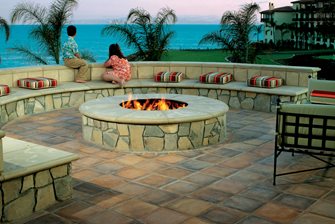 The imported 12x12" terra cotta paver is dangerously variable, which makes ARTO Brick quality high fired, American made stoneware tile designed to provide the desirable rustic Mexican look without the problems of irregular manufacture. This traditional paver is proving among the most popular for any style landscape in warmer regions.
The imported 12x12" terra cotta paver is dangerously variable, which makes ARTO Brick quality high fired, American made stoneware tile designed to provide the desirable rustic Mexican look without the problems of irregular manufacture. This traditional paver is proving among the most popular for any style landscape in warmer regions.
-
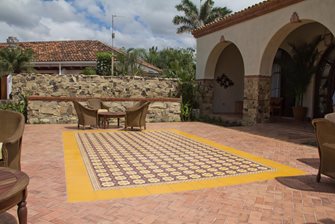 Known as a tile rug, this beautiful field of polychrome cement tile by Granada demonstrates the appeal of this new form of flooring. The ability to use this tile with very narrow grout joints results in precise patterns and colors for unique outdoor living spaces.
Known as a tile rug, this beautiful field of polychrome cement tile by Granada demonstrates the appeal of this new form of flooring. The ability to use this tile with very narrow grout joints results in precise patterns and colors for unique outdoor living spaces.
-
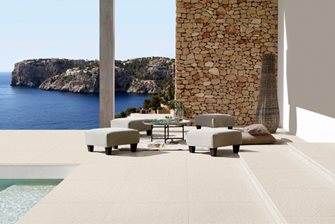 Integral Renovation Projects is both a contractor and importer of European made porcelain tile which is the hottest new tile trend for sleek modern architectural spaces. The density of porcelain and its precise dimensions allow it to be used in extreme freeze thaw and in conjunction with treated water.
Integral Renovation Projects is both a contractor and importer of European made porcelain tile which is the hottest new tile trend for sleek modern architectural spaces. The density of porcelain and its precise dimensions allow it to be used in extreme freeze thaw and in conjunction with treated water.
-
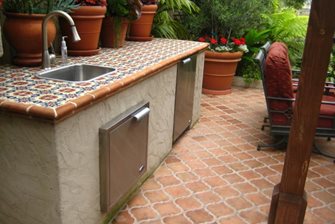 Brightly glazed Spanish style polychrome tiles are the natural partner for terra cotta floor pavers. Here the old Islamic design red clay tiles are small enough to add interest to this tiny space accented by the colors of the countertop.
Brightly glazed Spanish style polychrome tiles are the natural partner for terra cotta floor pavers. Here the old Islamic design red clay tiles are small enough to add interest to this tiny space accented by the colors of the countertop.
- 1
- 2
- 3
- 4
Tile is a very generic term that defines units of thin material applied onto a floor or wall. In the past, tiles were fired clay, but today the broadest range of this term includes a variety of units made out of a wide variety of materials. Some are manufactured to rehabilitate unusual surfaces such as wood decking without having to remove and replace the surface boards. Others are high tech ceramics as hard as stone and sometimes longer lasting. But when stone itself is cut into identical square or rectangular ultra thin units, it too becomes tile. Thus, tile can be an aesthetic choice or a problem solving one depending on the conditions of your homesite.
StyleCeramic tile was born in the warm Mediterranean region where it was known in Egypt and later the Romans utilized it in many ways within their homes. The colorful glazed ceramic tile evolved here too with the first Islamic designs demonstrated in historic Spanish villas. From there it was carried to Mexico where the same architecture featured similar ceramics in the New World. Again, these are warmer climates where the cool tile floors were much appreciated, and it has stuck to this Mediterranean inspired architecture in Florida, the Southwest and California.
Melanie Stephens of Granada Cement and Concrete Tile indicates the latest trends are away from perfect machine made products. "With the type of people who like our tile, there's an appreciation for handmade product and the inherent variations that come only with handmade. One incredible thing about having 32 colors for our Echo line and 200 different design molds, our client can lay any color into any mold so the possibilities are 20,000 variations. You can really see it's yours and you can really customize it."
- Pro Tip: A Thailand tile is machined and it has no soul. If you want something perfect buy porcelain -- Armen Alajian, Arto Brick
This is reflected by Armen Alajian of the family owned Arto Brick which specializes in high quality red clay patio pavers. "We have grown during a downturn so that indicates this is a trend. Go to the Piazza in Venice and you love that look. But customers want that with no maintenance...they don't realize it looks great over there because it's got signs of wear and use. The patina of use is desirable - it looks better when it gets dirty."
ClimateThis also defines the key limitation of tile. It can be problematic outdoors when exposed to extreme cold as well as excessive moisture and freeze thaw. Very dense tiles are more adaptable while those of uncertain origin or anything less than high density frost proof products may be damaged by moisture.
ScaleThe size of the area you have in mind will dictate what kind of tile you choose. Smaller spaces are more easily adapted to these smaller units. They also allow you to create beautiful accents or fields of color tiles known as a "carpet" in the center of a small space. The advantage to patios or walkways of smaller homes is that high end tiles are affordable due to the limited square footage. Larger expansive areas may benefit from using larger tiles such as 12x12 red clay or porcelain. Here accent tiles or color bands are useful for adding interest to large, uniform spaces. This is one of the great advantages of using tile. The ability to integrate colors and patterns more easily makes this the most diverse paving choice.
SubstrateTile is best laid on poured concrete slabs. This means you are literally paving the area twice: first with concrete and then with tile. Tile laid upon older slabs that may have cracks or lack expansion joints can cause serious damage to the tile. Those slabs that are not perfectly level will be subject to cracking too. The grout in mortar joints may also start to crumble. Often a "topping slab" must be poured to rectify this problem before tile can be laid. Knowing the nature of your substrate is crucial to choosing a tile that can withstand those conditions over time.
JointsNearly all tile requires grout joints which can vary considerably in depth and width. Contemporary designers seek to minimize the visibility of the joints. With Mexican Saltillo pavers, the joints are huge, at least an inch between tiles and nearly as deep. The gaps are due to irregularities in these tiles which require this width to accommodate odd sized tiles. This is important to consider because grout joints accumulate grime and are also vulnerable to disintegration for increased long term maintenance. That explains the growing trend for minimal joints in tile as well as stone, not for aesthetics but to eliminate the need for periodic cleaning. For minimal joints the tile must be precisely manufactured so that each one is straight and true. Often industrial grade tile is required to achieve this degree of precision, which is why it often appears in modern homes.
Related Reading:


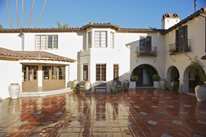 Outdoor Tile
Outdoor Tile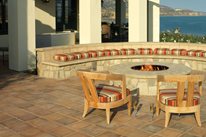 Outdoor Flooring
Outdoor Flooring Patio Tiles
Patio Tiles

